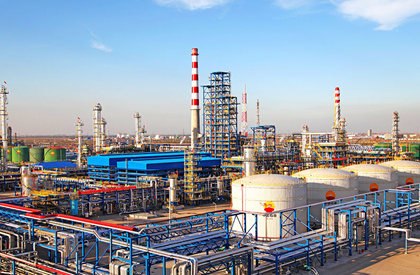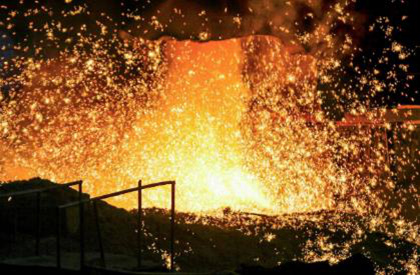03
2023-07
Boron oxide synthesis method is introduced
source:
Three common boron oxide synthesis methods:
1, atmospheric pressure method
The boric acid is sent to a heating kettle, and the temperature is heated, and the boric acid is slowly dehydrated. When the temperature rises to 107.5 ° C, it becomes metaborate (HBO2), when the temperature rises to 150 ~ 160 ° C, it becomes tetraboric acid (H2B4O7), above 650 ° C, the melt produces a large number of bubbles, and the temperature is eventually maintained at 800 ~ 1000 ° C, and the material is burned and dehydrated until it is red and bubbling. The relative density of molten material is 1.52. At this time, the drawing machine is opened for drawing, and the temperature is controlled at 700 ~ 900℃. Then the boron oxide wire of the wire drawing machine is cut off and packaged by the cutting machine to obtain the finished boron oxide product. The reaction equation is as follows: boron oxide
2. Vacuum method
Put boric acid in stainless steel dish, put it in oven for 1.5 h, then heat it to 150℃ for 4 h. Turn it frequently during the heating process to dehydrate it evenly. The material is then removed, cooled, crushed, then placed in a vacuum oven, kept sealed, heated at 220 ° C for 1.5 h, then heated to 260 ° C for 4 h. Then the material is cooled and crushed, put into a tube furnace, the heating temperature is controlled at 280℃, and the boron oxide product is prepared by dewatering under vacuum for 4h.
3. Put the crystalline boric acid in a small dish. It is placed in a drying reactor containing phosphorus pentoxide and heated under vacuum to 200 ° C to completely dehydrate. The vacuum provided by the water vacuum pump is sufficient, but it is better to use a vacuum pump with a higher vacuum degree. It is important that the temperature be slowly raised to 200 ° C, otherwise boric acid will fuse and prevent further escape of water vapor. The greater the amount used, the longer the heating time at 200 ° C should be, and sometimes the heat preservation reaches more than 4h, and the dehydration can be complete. For 3g boric acid, heat it for 1h. In addition, boric acid can be dehydrated in a dry air stream under the condition that the temperature is maintained at no more than 200 ° C. The dry air used is made by passing it through and then drying it through phosphorus pentoxide or porous barium oxide.
1, atmospheric pressure method
The boric acid is sent to a heating kettle, and the temperature is heated, and the boric acid is slowly dehydrated. When the temperature rises to 107.5 ° C, it becomes metaborate (HBO2), when the temperature rises to 150 ~ 160 ° C, it becomes tetraboric acid (H2B4O7), above 650 ° C, the melt produces a large number of bubbles, and the temperature is eventually maintained at 800 ~ 1000 ° C, and the material is burned and dehydrated until it is red and bubbling. The relative density of molten material is 1.52. At this time, the drawing machine is opened for drawing, and the temperature is controlled at 700 ~ 900℃. Then the boron oxide wire of the wire drawing machine is cut off and packaged by the cutting machine to obtain the finished boron oxide product. The reaction equation is as follows: boron oxide
2. Vacuum method
Put boric acid in stainless steel dish, put it in oven for 1.5 h, then heat it to 150℃ for 4 h. Turn it frequently during the heating process to dehydrate it evenly. The material is then removed, cooled, crushed, then placed in a vacuum oven, kept sealed, heated at 220 ° C for 1.5 h, then heated to 260 ° C for 4 h. Then the material is cooled and crushed, put into a tube furnace, the heating temperature is controlled at 280℃, and the boron oxide product is prepared by dewatering under vacuum for 4h.
3. Put the crystalline boric acid in a small dish. It is placed in a drying reactor containing phosphorus pentoxide and heated under vacuum to 200 ° C to completely dehydrate. The vacuum provided by the water vacuum pump is sufficient, but it is better to use a vacuum pump with a higher vacuum degree. It is important that the temperature be slowly raised to 200 ° C, otherwise boric acid will fuse and prevent further escape of water vapor. The greater the amount used, the longer the heating time at 200 ° C should be, and sometimes the heat preservation reaches more than 4h, and the dehydration can be complete. For 3g boric acid, heat it for 1h. In addition, boric acid can be dehydrated in a dry air stream under the condition that the temperature is maintained at no more than 200 ° C. The dry air used is made by passing it through and then drying it through phosphorus pentoxide or porous barium oxide.
Recommended news
-
What are the uses of boron oxi...
Boron oxide use 1, silicate analysis in the determination of silica and alkali, blow pipe analysis, decomposition o......
-
What are the advantages of bor...
1. Effects of water: Boric acid is the hydrate of boron trioxide, and its molecular formula is H3BO3, which can be expr......




